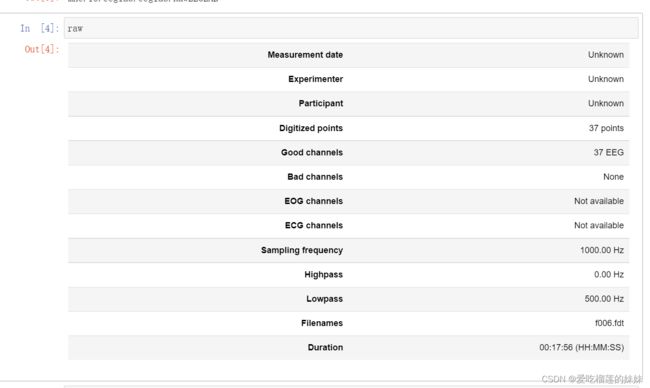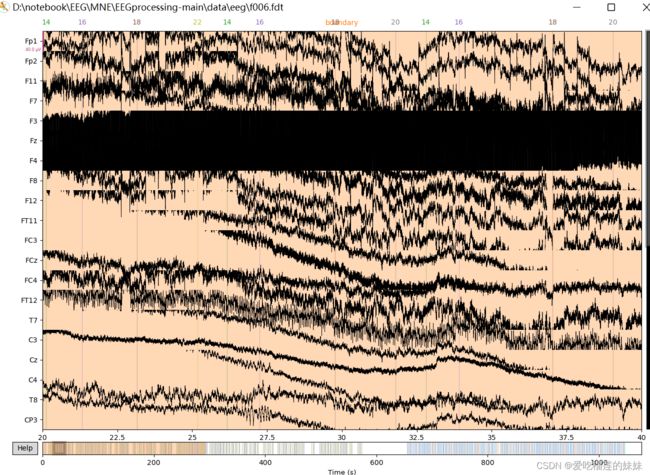MNE预处理脑电数据
1.mne安装和导入数据
import os
import numpy as np
import pandas as pd
import mne
import matplotlib.pyplot as plt
#可交互
%matplotlib qt #将数据读进来
raw = mne.io.read_raw_eeglab('data/eeg/f006.set')
#raw1 = mne.io.read_raw_edf('CHB-MIT\chb-mit-scalp-eeg-database-1.0.0\chb01\chb01_01.edf')
#查看raw类型
type(raw)
#type(raw1)#画一下数据图从第20秒开始,持续20秒
raw.plot(start=20,duration=20)
plt.show()2.剔除坏导
#导入数据并剔除无用channels
raw = mne.io.read_raw_eeglab('data/eeg/f006.set')
#告诉它哪个是eeg,哪个是eog
raw.set_channel_types({'VEOG':'eog'})
raw.pick(picks='all',exclude=['HEOG','EKG','EMG','Trigger']) #选出所有的导,不包括这几个,没有记录的无用数据
raw.plot(start=20,duration=1)
plt.show()3.裁剪片段
#找到并裁剪出我们需要的片段,比如说标记了的事件相关信号
events=mne.events_from_annotations(raw) #将raw里面的annotation读取出来
# print(events) #
# print(events[0][:,2]) # 0索引中所有行第三列的数值
# print(events[1]['14']) # 1索引中关键字为14的值
# print( np.where(events[0][:,2] == 3)[0]) #输出值为3对应的关键字
ind = np.where(events[0][:,2] == events[1]['14'])[0].min()
# print(ind)
start_t = events[0][ind,0] - 3000
ind = np.where(events[0][:,2] == events[1]['18'])[0].max()
end_t = events[0][ind,0] + 6500
#print(events[0][ind,0])
print(start_t,end_t) #从start裁到end时间
#因为crop裁剪操作不可逆,先进行copy一份进行裁剪处理。
raw_cropped = raw.copy()
#把数据从min裁剪到max
raw_cropped.crop(tmin = start_t/1000,tmax = end_t/1000)
raw_cropped.plot(start=20,duration=1)
plt.show()
#因为数据集和视频老师的不一样,所以出现错误,自己改了长短
#定义坏导,在图像中点击fz
raw_cropped.info['bads']4.定位电极
#定位电极,用坏导周围的电极来平均坏导的值
raw_cropped.set_montage('standard_1020',on_missing='warn') #定义eeg 10-20模板 周围的四个电极在模板里找不到,位置太下了,所以就警告5.插值坏导
#插值坏导
raw_cropped.load_data()
raw_cropped.interpolate_bads(exclude=['F11','F12','FT11','FT12']) #对raw对象进行插值坏导
raw_cropped.plot(start=20,duration=1,n_channels=33,block=True,title='坏导插值完成,如无误请关闭窗口')
plt.show()6.低通滤波
#低通滤波
raw_filter = raw_ref.copy()
raw_filter.filter(l_freq=1,h_freq=None) #只做了低通滤波
#raw_filter.notch_filter(freq=50) #一般做一个50hz凹陷滤波,事件干扰工频干扰
raw_filter.plot_psd(fmax=60)
plt.show(block=False)
raw_filter.plot(start=20,duratioon=1,block = True,title='低通滤波完成,准备ICA,无误请关闭窗口')
7.去伪迹,跑ICA
#去伪迹,选用ICA
#先定义ica方法
ica = mne.preprocessing.ICA(n_components=10,method='picard',max_iter=800) #10个一组,训练800次
ica.fit(raw_filter) #训练
raw_filter.load_data()
ica.plot_sources(raw_filter,show_scrollbars=True,block=True,title='请选择需要除去的成分') #主成分分析跑出来,
plt.show() #在图中选中需要去除的成分
# print(ica)
# raw_recons = raw_filter.copy()
# raw_recons = ica.apply(raw_recons)
# raw_filter.plot(start=20,duration=1,n_channels=33,title='ICA处理前,确认请关闭')
# raw_recons.plot(start=20,duration=1,n_channels=33,title='ICA处理前,确认请关闭')
# plt.show(block=True)#跑完ICA,画前后对比图
print(ica)
raw_recons = raw_filter.copy()
raw_recons = ica.apply(raw_recons)
raw_filter.plot(start=20,duration=1,n_channels=33,title='ICA处理前,确认请关闭')
raw_recons.plot(start=20,duration=1,n_channels=33,title='ICA处理前,确认请关闭')
plt.show(block=True) #关闭窗口程序可以接着往下走8.高通滤波凹陷滤波
#高通滤波与凹陷滤波
raw_recons.filter(l_freq=None,h_freq=30)
raw_recons.notch_filter(freq=50)9.提取epochs
#提取epochs 把感兴趣的epochs提取出来
#先将标记的注提取出来,放到events里面
events = mne.events_from_annotations(raw_recons)
events #可以看一下,events有5种注释 tupe类型 [1]有三列,时间,不用看,对应的值。
event_dic = ['pos':events[1]['20'],'neg':events[1]['22']] #感兴趣的是正值和负值,对应的是20和22标签的值
reject_criteria = dict(eeg=100e-6) #拒绝振幅大于100uV的eeg,振幅过大。可选可不选
#raw数据是一整段,epoch就是提取的一小段一小段数据,与你感兴趣的事件相关的那一段eeg
# 数据读进来 取array, 感兴趣的事件, 加载数据 提取事件前200毫秒到事件后1秒 振幅过大不要
epochs = mne.Epochs(raw_recons,events[0],event_id=event_dic,preload=True,tmax=1,tmin=-0.2,reject=reject_criteria)
epochs.plot(events=events[0],block=True,title='请目视挑选出来坏EPOCHES')
plt.show() #点击坏的片段10.平均epochs
#对每个片段平均 对pos和neg分别做平均
#先复制
pos_epochs = epochs['pos']
neg_epochs = epoch['neg']
pos_evoked = pos_epochs.average()
neg_evoked = neg_epochs.average()
neg_evoked.plot() #最后画出 负200毫秒到1秒之间32个导的平均值,异常的为坏导#将32个导进行平均
# 两种epoch之间的对比,取全部32个导的平均 上正下负,
mne.viz.plot_compare_evoked(dict(positive=pos_evoked,negative=neg_evooked),combine='mean',picks=np.arange(32),invert_y=True,legend=True,ci=True)





